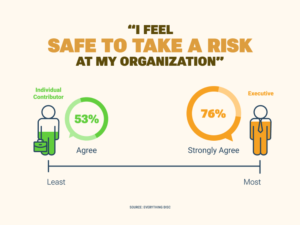Welcome back! If you’ve been on this series with us, you know we’ve talked about inclusion, belonging, and the quest for equality. Today, we stand at the fourth installment in our series: Creating Safety.
Workplace safety isn’t just about physical well-being; it’s about being your true self without fear or reservation. It’s about knowing that when you step into a room, your voice will be heard, your ideas respected, and your presence cherished.
Understanding safety in hiring procedures
First off, safety here isn’t just about physical stuff, like having sturdy chairs or good lighting (although those are important too!). It’s more about creating an environment where people feel mentally safe to be themselves. Think of it as a space where you can share your ideas, experiences, and quirks without worrying about judgment or bias.
Now, why is this so crucial during the hiring process? Well, picture yourself as a candidate from a different background, maybe a different race, gender, or culture. You’re already a bit nervous about putting yourself out there. Safety in this context means you’re not worried that your differences might count against you. You want to know that the company values what makes you unique and won’t hold it against you.
But here’s the thing: when there’s a lack of safety in hiring, it’s like a big roadblock to diversity. If candidates feel like they won’t be treated fairly or their differences might be used against them, they might not even bother applying. So, companies miss out on all these amazing perspectives and talents just because folks didn’t feel safe to show up as themselves.
According to a survey made by Everything disc, there is a gap in psychological safety according to their position in the organization.

Support systems for your talent
Support systems are the backbone of a thriving and inclusive workplace. They’re like safety nets, catching us when we stumble and empowering us to achieve our full potential. For me, mentorship programs have been a game-changer. Pairing new hires with experienced mentors, who provide guidance and advocacy, especially for those from underrepresented backgrounds, creates a path for success. Support systems are more than just perks; they’re essential for our retention, engagement, and the success of our diversity initiatives. When we feel supported, we’re more likely to stay, perform at our best, and contribute to a positive company culture.
Accessibility support ensures that everyone has the resources and accommodations to thrive. These efforts not only demonstrate a commitment to inclusivity but also celebrate the diverse talents within our workplace.
Putting hands in actions: Policies and Training
Without clear policies and effective training, a company can drift into unsafe waters where bias and discrimination lurk.
But when policies are crystal clear, and everyone is trained to recognize and challenge bias, that’s when the magic happens. That’s when diverse candidates feel confident to step aboard, knowing they’re entering a safe harbor where their talents are valued, not their stereotypes.
Policies are the official rules that set the tone for how everyone should be treated, regardless of their background.
For example, the Australian Human Rights Commission suggests several policies to start with, such as:
- A comprehensive workplace safety policy.
- Mental health policy covering consultation, confidentiality, and training.
- Broad equity and non-discrimination policies (including disability and mental health).
- Harassment and bullying policy (possibly within an OHS or equity policy).
- Feedback policy.
- Procedures for prompt, fair, and appropriate reasonable adjustments.
But it’s not enough to have policies gathering dust in a folder o a draft in the cloud. You must consider training, not as an expense but as an investment in the future. Training isn’t just about what not to do; it’s about what to do like equipping hiring managers with the skills to recognize talent beyond stereotypes.
As we strive for a workplace where everyone can bring their whole selves to work, safety emerges as the catalyst for change. It’s the force that drives us to confront biases, challenge norms, and build bridges of understanding. When we prioritize safety in hiring procedures, we’re not just opening doors; we’re tearing down barriers!
As we near the conclusion of our series, stay tuned for our upcoming articles. For further details about EQUALS TRUE, feel free to reach out to us via email at hello@equalstrue.tech or visit our website at https://equalstrue.tech.
We’re all eyes! Share your insights, stories, and suggestions in the comments section below. Keep an eye out for our next articles as we strive for a workplace that embraces equity and inclusivity.
Copyright © 2024 EQUALS TRUE. All Rights Reserved.





